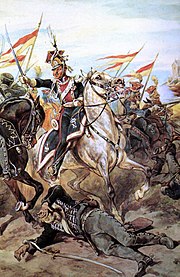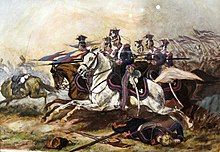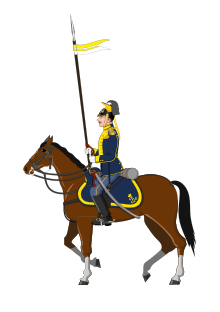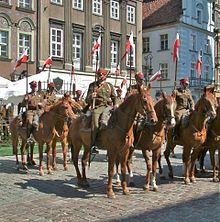Uhlan
This articleneeds additional citations forverification.(June 2021) |

Uhlan(/ˈuːlɑːn,ˈjuːlən/;French:uhlan;‹See Tfd›German:Ulan;[1]Lithuanian:ulonas;Polish:ułan) is a type of light cavalry, primarily armed with alance.[2]The uhlans started asLithuanianirregular cavalry,[3]that were later also adopted by other countries during the 18th century, includingPoland,France,Russia,Prussia,Saxony,andAustria-Hungary.The term "lancer"was often used interchangeably with" uhlan "; the lancer regiments later formed for the British Army were directly inspired by the uhlans of other armies (even though they were never known by that name).
Uhlans traditionally wore a double-breasted short-tailed jacket with a colouredplastronpanel at the front, a colouredsash,and a square-topped Polish lancer cap (rogatywka,also calledczapka).[4]This cap or cavalry helmet was derived from a traditional Polish cap design, formalised and stylised for military use.[4]Their lances were traditionally topped with a small, swallow-tailed flag (pennon) just below the spearhead.[4]
Etymology
[edit]There are several suggested etymologies for the worduhlan.[5]In theTurkiclanguages,oğlanmeans 'youngman' or 'boy'.[6][7]It is probable that this enteredPolishviaTatarand was styled asułan.[5][7]The Polish spelling was thenadoptedby German, French, and other European languages.[8]
History
[edit]Origins
[edit]In the late 14th century,Golden HordeTatar(sometimes spelledTartar) families settled inLithuaniaand so were required to serve theGrand Duke of Lithuaniamilitarily and later thePolish king.The Poles started incorporating much of their military vocabulary and traditions, along with their strategy and tactics.Lithuanian Tatars,served as part of the Royal armies during various battles of the lateMiddle Ages.Their tasks were to conductreconnaissancein advance of theheavier cavalrybanners (knights). With the end of armoured knights during the 16th century, the Lithuanian Tatars were organized in light (Tatar) banners – armed with a light lance, bow, sabre, and on occasion, a battle axe orhorseman's pick,serving ascompanions(towarzysz) andretainers(pocztowy) – while equally lightly armed hussars were converted into heavy companies ofwinged hussars.[9]Tatar companions serving within their own Tatar companies (banners) lasted until the 1770s, when major cavalry reforms were carried out within the Polish–Lithuanian army and were included in the reformed cavalry regiments. The last Polish king,Stanisław August Poniatowski,had an uhlan guard regiment simply known as the Royal Uhlans. It was disbanded in 1794 or 1795.
Uhlans frequently adopted a practice of the original Lithuanianlancers:attachingpennonsto lances to look moreawe-inspiring.[3]


18th century
[edit]Uhlan units started emerging in Western European armies during theWar of Austrian Succession,starting with an uhlan squadron, known as theNatzmer Uhlanen,formed byFrederick the Greatin 1740.[10]The next year, the squadron was expanded to an uhlan regiment, finally being transformed into Natzmer's 4th Hussar Regiment in 1742.[10]
Simultaneously, in 1743,Maurice de Saxeformed a mixed uhlan-dragoon regiment, theVolontaires de Saxe,forLouis XV'sFrench Royal Army.[3][10]It was composed of six companies, each of eighty dragoons and eighty uhlans, and included Lithuanian, Polish and Tatar soldiers.[10]The regiment was known for itsbravery,fighting spirit, and alcoholism.[10]
The first uhlan regiments were created in the early 18th century, during the 1720s, in thePolish–Lithuanian Commonwealth.
As developments in battlefield tactics and firearms had combined with the increasing sizes of early modern armies to make heavy armour obsolescent (though retained by thecuirassierregiments), lighter units became the core of thecavalry,distinguished only by the sizes of their men and mounts and by the tasks that they performed (i.e.,reconnaissance, skirmishing, or direct charges).
During the period preceding thePartitions of Poland,uhlan formations consisting of Poles orLithuanian Tatarswere created in most surrounding states simply because the Polish Crown did not have the resources or political will to maintain a numerous army. Speed and mobility were the keys to the effectiveness of light cavalry armed with lances.
KingStanisław August Poniatowskiof Poland formed a regiment of royal guards equipped with lances,szablas,and pistols, each guardsman uniformed inkurtkaandczapka.This unit became the prototype for many other units of thePolish cavalry,who started to arm themselves with equipment modelled after uhlan regiments and medieval Tatars.

In thePolish–Lithuanian Commonwealth,the uhlans inherited the status and traditions of the wingedPolish hussarsin 1776, thus becoming National cavalry. TheAustrian empirealso formed an "Uhlan Regiment" in 1784, composed primarily of Poles. Uhlan regiments recruited from Austrian cavalrymen were raised in 1791.

19th century
[edit]During theNapoleonic Wars,theDuchy of Warsawraised uhlan formations. Polish lancers serving with the French Army included theLegion of the Vistulaand the1st Polish Light Cavalry Regiment of the Imperial Guard.TheImperial Guardlancers were armed withLances,SabresandPistols.[11]The lancers of the Polish expeditionary corps, which fought alongside the French in Spain and Germany, spread the popularity of the Polish model of light cavalry. After theBattle of Somosierra,Napoleonsaid that one Polish cavalryman was worth 10 French soldiers. Thechevaux-légers,French light cavalry units from the 16th century till 1815, were remodelled after the uhlans. Following theTreaty of Tilsitin 1807, lancer regiments designated as uhlans were reintroduced in the Prussian service. Initially, they were only three. After theWar of the Sixth Coalition,uhlan regiments were formed fromLützow Free Corps,Schill Free Corps, Bremen Volunteers and Hellwig'sStreifkorps.[12]
During and after the Napoleonic Wars, cavalry regiments armed with lances were formed in many states throughout Europe, including the armies of Italy, Spain, Portugal, Sweden and Russia. While cavalry carrying this weapon was usually specifically designated as lancers or uhlans, in some instances, the front rank troopers ofhussarordragoonregiments were also armed with lances.[13]
Inone notable actionduring theWaterloo Campaignas the French lancers advanced out of adefile— created by the bridge over theDyleand the village ofGenappe— although they were stationary as they formed up, they lowered their lances to receive a charge by the sabre wielding British7th Hussars(light cavalry) who were then unable to press home their charge. However, once the lancers advanced in slight disorder (up the valley slope of the Dyle), they were overridden by the British1st Life Guards(heavy cavalry armed with sabres) who drove them back through Genappe and onto the bridge.[14]
During theBattle of Albuera,the1st Vistulan Lancers Regimentin French service virtually annihilated three of four of the British infantry regiments comprisingColborne's 1st Brigade. In 1816, theBritish Armyestablished its own lancer regiments, converting fourlight dragoonregiments for the purpose[15]and practically adopting the whole uniform of Napoleon's famous Polish Lancers, including the czapska.[16]

The traditions of the Polish uhlans were preserved during theKingdom of Poland.They fought both in theNovember uprisingof 1830 and in theJanuary uprisingof 1863. Uhlans were deployed in theFranco-Prussian Warby thePrussian Armyin a variety of traditional light cavalry roles. During thesiege of Paris,uhlans were tasked with shadowing passenger balloons launched from the city: their capacity for rapid movement made uhlans the only troops able to keep pace with the balloons, either to seize them on landing or at least report trajectory and destination.[17]

World War I
[edit]At the start of the First World War, many European armies had lance-armed cavalry regiments. Belgium had five lancer regiments.[18]Italy possessed 10 lancer regiments.[19]Great Britain had six lancer regiments,[20]with an additional 15 in the army of theBritish Raj.[21]

German uhlans
[edit]In 1914, theImperial German Armyincluded 26 uhlan regiments,[22]three of which were Guard regiments, 21 line (16 Prussian, twoWürttembergand three Saxon) and two from the autonomousRoyal Bavarian Army.All German uhlan regiments wore Polish styleczapkasandtunicswithplastronfronts, both in colouredparade uniformsand the field greyservice dressintroduced in 1910. Because Germanhussar,dragoonandcuirassierregiments also carried lances in 1914, there was a tendency among their French and British opponents to describe all German cavalry as "uhlans".
The lance carried by the uhlans (and after 1889 the entire German cavalry branch) was known as theStahlrohrlanzewhich consisted of a 3.18 m (10.4 ft) long tube made of rolled steel-plate, weighing 1.6 kg (3.5 lb). The lance carried below its head a small pennant in different colours according to the province or state from which the regiment was recruited. The quadrangular spear point was 30 cm (12 in) long and made of tempered steel. The butt end of the shaft was also pointed so that (in theory) the lance could be wielded as a double-ended weapon.
After seeing mounted action during the first few weeks ofWorld War I,the uhlan regiments were either dismounted to serve as "cavalry rifles" in the trenches of theWestern Frontor they were transferred to theEastern Frontwhere the more primitive battle conditions made it possible for horse cavalry to fulfill their intended role. All 26 German uhlan regiments were disbanded in 1918–1919.

Austrian uhlans
[edit]There were 11 regiments of uhlans (spelt "Ulan" ) in theAustro-Hungariancavalry, largely recruited in the Polish-speaking parts of the Empire. They wore czapkas in regimental colours but otherwise were, after 1867,[23]dressed in the light blue tunics and red breeches of the Austro-Hungarian dragoons, without Polish features. Their lances were similar in design to those of the German cavalry but had wooden shafts (of ash). In 1884 the lance was replaced by the sabre in the Austro-Hungarian cavalry, although theUlanregiments retained their traditional titles and lancer caps until World War I.[24]
As with other armies, the Austro-Hungarian uhlans were forced into a largely dismounted role by the realities of trench warfare by the end of 1914. Consequently, the blue and red peacetime uniforms were replaced by field grey during 1915. There was, however, one last opportunity for traditional glory when on 21 August 1914, the uhlans and dragoons of the Austro-Hungarian4. Kavallerietruppendivisionclashed with their counterparts of the Imperial Russian10th Cavalry Divisionin classic cavalry style at theBattle of Jaroslavice.


Polish uhlans
[edit]Józef Piłsudski'sPolish Legions(an independent formation serving with the Austro-Hungarian Army) had a small uhlan detachment. Commanded byWładysław Belina-Prażmowski,they were modelled after the uhlans of the Napoleonic period. This unit was the first element of theCentral Powersto enter Polish lands duringWorld War I.After Poland's independence in 1918, all parts of the country raised uhlan formations. They fought with distinction in theGreater Poland Uprising,thePolish-Ukrainian Warand thePolish-Bolshevik War.Although equipped with modernhorse-drawn artilleryand trained ininfantry tactics,the uhlan formations kept theirsabres,their lances and their ability tochargethe enemy. Among other battles, the uhlan units took part in theBattle of Komarówof 1920 against the invading SovietKonarmia,the last pure cavalry battle in history.
Russian uhlans
[edit]
TheImperial Russian Armyhad converted its 17 line uhlan regiments to dragoons in 1881 as part of the general modernization of the Russian cavalry. Only the twoRussian Imperial Guarduhlan regiments retained their special distinctions.[25]In 1910, however, the historic line regiments of uhlans had their lances, traditional titles, and distinctive ceremonial uniforms returned to them. From 1910 to 1918, the designation of "uhlan" had, however, become simply a historical distinction in the Russian cavalry (many of whom carried lances), without tactical significance.[26]

Interwar
[edit]In theperiod between the World Wars,thePolish cavalrywas reformed, with some units retaining their uhlan traditions. However, in contrast with its traditional role, the cavalry was no longer seen as a unit capable of breaking through enemy lines. Instead, it was used as a mobile reserve and employed infantry tactics: the soldiers dismounted before the battle and fought as infantry (dragoon), yet retained the high mobility of cavalry. Thus, technically speaking, in 1939, Poland had 11 brigades of mounted infantry and no cavalry units.
As noted above, the uhlans of the Imperial German Army were disbanded at the end of World War I. However, lances continued to be carried by certain cavalry regiments of the new German Army (Reichsheer) permitted by the Treaty of Versailles. As late as 1925, Major Generalvon Seeckt,Commander of the Reichsheer, rejected a General Staff proposal that lances be abandoned as unsuited for a modern army.
World War II
[edit]While the Polish cavalrymen retained their sabres, the lance was no longer a standard issue after 1934 (or 1937). However, the lance was retained only for training purposes and flying squadron pennants.[27]Instead, the cavalry units were equipped with75mm field guns,light tanks,37mm anti-tank guns,40mm anti-aircraft guns,as well asanti-tank riflesand other modern weapons. Although there were cavalry charges duringWorld War II,very few were successful.
A popular myth is that Polish cavalry armed with lances charged (and were annihilated by) German tanks during the September 1939 campaign. This arose from the misreporting (both intentional and unintentional) of theCharge at Krojantyon 1 September, when the18th Pomeranian Uhlan Regiment's two squadrons armed with sabres, scattered German infantry before being caught in the open by German armoured cars.[28]
When the remnants of the Polish cavalry forces were reconstituted in exile in 1943 as the1st Armoured Divisionthe 24th Uhlans (24 Pułk Ułanów) were equipped as an armoured regiment with Sherman tanks. The regiment was disbanded in 1947.
Modern
[edit]
Present-day military units with the title or historical role of "uhlans" include:
- Kazakhstan:Жас Ұлан(zhas ulan) regiments exist in the modern Kazakhstan Army[29]though not as mounted cavalry.
- Poland:Presidential Mounted Cavalry Squadron of Polish Armed Forces(Polish:Szwadron Kawalerii Wojska Polskiego)[30]
- Lithuania:Grand Duchess Birutė Uhlan Battalion (Lithuanian:Didžiosios kunigaikštienės Birutės ulonų batalionas)[31]this unit has the historic title, but not the cavalry role. It is a combat battalion.
In popular culture
[edit]Video games
[edit]- InFinal Fantasy XII: The Zodiac Age,one of the 12 playable character classes is named "Uhlan" and wields Lances and Spears.
- Many light to medium Battlemech and combined arms regiments in theBattleTech/MechWarrioruniverse useuhlansin their unit names (e.g., the 1st Kathil Uhlans).
- Age of Empires III:uhlans are the primary cavalry unit of the German civilization.
- Mount & Blade: With Fire & Sword:A lance-armed light cavalryman called an "oglan" can be found in service of theCrimean Khanate.
Literature and film
[edit]- Uhlans are mentioned inArthur Conan Doyle's short story "The Lord of Chateau Noir".
- The 19th century Germanpulp-fictionnovelDie Liebe des Ulanen(″The Uhlan's Love″) byKarl Mayhas, like everything else by this author, acquired cult status in German-speaking countries and, although several thousand pages long, is still in print.
- InLeo Tolstoy's seminal workWar and Peace,uhlans appear several times from the start of Book III.
- InGuy de Maupassant's short story "Father Milon",16 uhlan soldiers of the Prussian army are killed by the old protagonist, Father Milon.
- InJoseph Roth's 1932 novelThe Radeztky March,the protagonist is an officer of the Austro-Hungarian uhlans.
- In the 1943 filmThe Life and Death of Colonel Blimp,Theo Kretschmar-Schuldorff is an officer of the uhlans.
- InGraham Greene's 1958 novelOur Man in Havana,Dr. Hasselbacher is an ex-uhlan officer.
- InGunther Grass's 1959 novelThe Tin Drum,the protagonist Oskar Matzerath frequently refers to the Polish uhlans as well as their misreported charge on 1 September 1939.
- InItalo Calvino's 1979 novelIf on a winter's night a traveler,Gritzvi (Outside the town of Malbork) prizes his uhlan helmet and is reluctant to leave it in Ponko's care.
- In thescience fictionshort storyHe Walked Around the HorsesbyH. Beam Piper,Prussian uhlans play an important role, it is they who first meet the diplomatBenjamin Bathurstwho had slipped from our world into anAlternative Historytimeline.
- Anton Hofmiller, the narrator ofStefan Zweig'sBeware of Pity,is an officer in an uhlan regiment in 1913 Austria-Hungary.
- Battle Picture Weekly's popular feature "Charley's War",byPat Mills&Joe Colquhoun,had uhlans playing a major role in episodes 252 & 253.
- InStar TrektheRomulanequivalent of anensignis an uhlan.
Culture
[edit]- Traditional Polish and Ukrainian songHej Sokoły.
Sports and organisations
[edit]- "Black Uhlan of the Rhine" – the nickname of a heavyweight championMax Schmeling.
- Valparaiso University's sports teams were nicknamed "Uhlans" until World War II, then changed to "Crusaders".
- The Black Uhlans is the name of one of Australia'sOutlaw motorcycle clubsthat has been active since 1970.
See also
[edit]Notes
[edit]- ^Weekley 1921,p. 1563.
- ^Melegari 1972,p. 16.
- ^abcLawford 1976,p. 140.
- ^abcHaythornthwaite 2012.
- ^abBarrows 1916,p. 392.
- ^Grbašić & Vukšić 1989,p. 133.
- ^abSpeake 2000,p. 448.
- ^Skeat 2005,p. 659
- ^Roemer 1863,p. 345; At its reorganization in 1717, the Polish–Lithuanian army contained both heavy and light cavalry... The light cavalry was also composed of Polish noblemen, but the Tartars, whom a grand duke of Lithuania had received into his states during the conquests of Tamerlane, were admitted on an equal footing, both as officers and privates. They wore no defensive armour, but in other respects, were equipped like the heavy cavalry, only in a less costly manner. One of their first leaders was a Lithuanian nobleman named Huland, whence the term hulan or uhlan [comes]
- ^abcdeGrbašić & Vukšić 1989,p. 98.
- ^Shepperd 1972,p. 100.
- ^Haythornthwaite 1986,p. 158.
- ^Rawkins 1977,p. 27.
- ^Siborne 1848,pp. 276–281.
- ^Barthorp 1984,p. 88.
- ^Funcken & Funcken 1967,p. 52.
- ^Horne 2007,pp. 129–130.
- ^Funcken & Funcken 1971,p. 36.
- ^Funcken & Funcken 1971,p. 50.
- ^Funcken & Funcken 1971,p. 40.
- ^Funcken & Funcken 1971,p. 44.
- ^Funcken & Funcken 1971,p. 54.
- ^Knötel, Knötel & Sieg 1980,pp. 30–31.
- ^Lucas 1987,p. 112.
- ^Picard 1897,p. 394.
- ^Cornish & Karachtchouk 2001,p. 13.
- ^Zaloga 1983,p. 5 & 32.
- ^Zaloga 1983,p. 8.
- ^"Генерал С.Қ.Нұрмағамбетов атындағы" Жас ұлан "республикалық мектебі"[Republican school "Zhas Ulan" named after General SK Nurmagambetov]. Archived fromthe originalon 22 July 2011.Retrieved24 August2010.
- ^http://www.brepr.wp.mil.pl/en/49.html[dead link]Archived18 May 2015 at theWayback Machine
- ^Didžiosios kunigaikštienės Birutės ulonų batalionastr. Grand Duchess Birutė's Ulons Battalion,accessed 18 December 2020
References
[edit]- Barrows, John Stuart (January 1916)."The Uhlans and Other Cavalry in the European War".Journal of the United States Cavalry Association.26.
- Barthorp, Michael (1984).British Cavalry Uniforms Since 1660.Blandford Press.ISBN0-7137-10438.
- Cornish, Nik; Karachtchouk, Andrei (2001),The Russian Army 1914-18,Oxford:Osprey Publishing,p. 13,ISBN1-84176-303-9
- Funcken, Fred; Funcken, Lilianne (1967).Le costume et les armes des soldats de tous les temps(in French).Tournai:Casterman.ISBN2-203-14303-7.
- Funcken, Fred; Funcken, Lilianne (1971).L'uniforme et les armes des soldats de la guerre 1914-1918(in French). Vol. 2.Tournai:Casterman.ISBN2-203-14309-6.
- Grbašić, Z.; Vukšić, V. (1989).The History of Cavalry.Facts on File.ISBN0-8160-2187-2.
- Guchinova, Elza-Bair (2006).The Kalmyks.Great Britain:Routledge.ISBN978-0-7007-0657-0.
- Haythornthwaite, Philip J. (1986).Uniforms of Waterloo in colour, 16-18 June 1815.Hong Kong:Blandford Press.ISBN0713707143.
- Haythornthwaite, Phillip J. (2012).Austrian Army of the Napoleonic Wars.Vol. 2 (Cavalry).Bloomsbury Publishing.ISBN9781782007036.
- Horne, Alistair (2007).The Fall of Paris.Penguin Books. pp. 129–130.
- Knötel, Richard; Knötel, Herbert; Sieg, Herbert (1980).Uniforms of the World.New York:Arms and Armour Press.ISBN0-684-16304-7.
- Lawford, James (1976).Cavalry - Techniques & Triumphs of the Military Horseman: The Stories of the Great Cavalry Regiments, their Commanders and celebrated Actions.Indianapolis:Bobbs-Merrill Company.ISBN0-672-52192-X.LCCN79-5986.
- Lucas, James (1987).Fighting Troops of the Austro-Hungarian Army 1868-1914.Hippocrene Books.ISBN0-946771-04-9.
- Melegari, Vezio (1972).The World's Great Regiments.Netherlands.ISBN0600338991.
{{cite book}}:CS1 maint: location missing publisher (link) - Picard, Louis Auguste (1897).L'armée en France et à l'étranger(in French).Tours.
{{cite book}}:CS1 maint: location missing publisher (link) - Rawkins, W.J. (1977).The Russian Army 1805 – 14.Anschluss Publishing.
- Roemer, Jean (1863).Cavalry; its history, management, and uses in war... With illustrations.p. 345.
- Shepperd, Gilbert Alan (1972).A history of war and weapons, 1660 to 1918.United States of America.ISBN0-690-39367-9.
{{cite book}}:CS1 maint: location missing publisher (link) - Siborne, William (1848).The Waterloo Campaign, 1815(4th ed.).Westminster:A. Constable.
- Skeat, Walter William (2005).A Concise Etymological Dictionary of the English Language.Lightning Source Incorporated.ISBN9781596050921.
- Speake, Jennifer(2000).The Oxford dictionary of Foreign Words and Phrases.Oxford University Press.ISBN9780192801128.
- Weekley, Ernest (1921).An etymological dictionary of modern English.
- Zaloga, S. J. (1983).The Polish Army 1939–45.London:Osprey Publishing.ISBN0-85045-417-4.
Further reading
[edit]- Coil, Spencer A. (2003).Uniforms & Equipment of the Austro-Hungarian Army in World War I.Schiffer Pub.ISBN0764318691.OCLC55948007.
- Marrion, R.J. (1975),Lancers and Dragoons,Almark Publishing Company Ltd.,ISBN0-85524-202-7.
- Sanders, Paul (2010).Regimental Steins of the Kaiser's Cavalry: Kürassier, Dragoon, Jager Zu Pferde, Hussar, Uhlan.Schiffer Pub.ISBN9780764336836.OCLC642837794.
External links
[edit] Media related toUhlanat Wikimedia Commons
Media related toUhlanat Wikimedia Commons- The Uhlan
- Etymology OnLine
